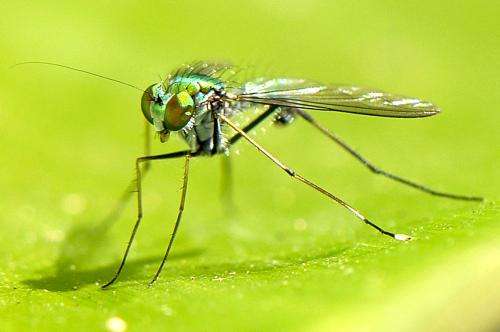A fly from the same family (Dolichopodidae) as the 19 newly described species found in the Pilbara. Credit: Sam Fraser-Smith
A Sydney-based entomologist has described a new single-species fly genus, found only at Millstream near Karratha.
Pilbara octava is a member of the family Dolichopodidae, and one of 19 new species that Australian Museum expert Dr Daniel Bickel described during a survey of Pilbara flies.
He says it helps tell the tale of a time when much of central Australia was moist and forested and the various species he found in the Pilbara were widely-distributed across the continent.
"As it gets drier a lot of these species can only survive in areas where there's like permanent water," he says.
"Places like Millstream, which is an old river system that has permanent water holes, certainly might be a sort of place where you would find these sort of things."
He also recorded 25 flies already described.
"One of the things that also came through in this...is how many species are actually not only just Australian but they are actually found in New Guinea and some even go out to the Solomons," he says.
Dr Bickel says he found only one species (Parentia vulgaris) that is not of a "tropical" genus.
"It's from a group that otherwise is only [found in] southern Australia and New Zealand and something which is much more of a typical Gondwanan cool-adapted group," he says.
"It also gets into the Queensland tropics.
"Often what you find in these genera, you find most of the genus are often tied to a certain habitat or a certain climatic region.
"And yet there's always a few that break out and sort of adapt — that's the way that these things get around and expand their ranges."
While Dr Bickel did some collecting of his own near Cape Range and further inland, he says most of the survey involved studying unclassified material already preserved in collections at CSIRO Canberra, the Australian Museum in Sydney, and the WA Museum.
"I didn't do any DNA bar coding on this," he says.
"I'm just doing very basic description, morphologic description.
"A lot of the specimens that are used, these are the old dried specimens.
"You can't get good DNA barcodes out of them."
He says Chevron agreed to fund the whole-of-Pilbara study when it asked him for an inventory of Barrow Island flies.
"We can now say what's on the island and if there's any change that occurs there we can say we had a baseline set of data to begin with."
Provided by Science Network WA
























